Tarapith: Fire, Blood, Magic, and Sati’s Third Eye
Is Tarapith a Shakti Pith?
While Tarapith is often not considered a “true” shakti pith due to its rather curious omission from the list of 51 sacred sites found in the Mahapithanirupana, it most certainly is regarded as such in the realm of popular belief. For the masses of devotees who flock to this temple, Tarapith is where Sati’s third eye fell to the earth countless aeons ago. Traditionally associated with both mystical vision and spiritual fire, the third eye is one of the most powerful attributes of the Great Goddess. The fact that Tarapith is said to be the site where Sati’s third eye landed demonstrates the tremendous amount of respect and reverence accorded this “place of power” by goddess devotees.
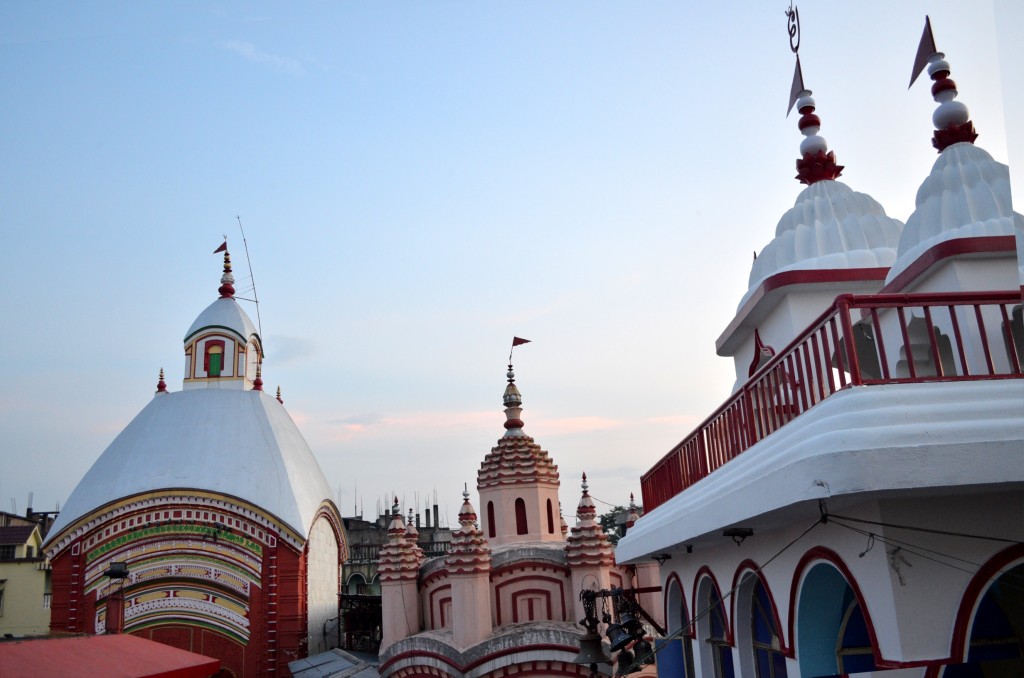
The Tarapith Temple Complex
Without doubt, the association of Tarapith and the Great Goddess’ spiritual eye runs very deep. Over the years, I have heard this story repeatedly told by Bengali Hindus. At various shrines and temples throughout West Bengal, I have found calendar art prints on display which clearly link Ma Tara’s image and Sati’s third eye together within the context of the shakti pith mythos. A very important point that I have yet to see mentioned in any books concerning Tara relates to the etymology of the goddess’ name. “Tara” is often simply explained away as being the Sanskrit word for “star” and left at that. While this is indeed accurate and a very important attribution, what gets overlooked is that in Bengali the word tara not only means “star,” but is also is the same word as that used for “pupil.” Thus the idea of a “star” and an “eye” are not only bound together through her iconography and mythology, but also in the shared meaning of the goddess’ name.
When speaking with locals about Tarapith, it becomes very clear that this place is commonly regarded not only as the most important siddha pith (a place where spiritual practices yield faster and more powerful results) of West Bengal, but as one of the most important shakti piths of all, perhaps second in importance to the Kamakhya Mandir in Kamrup, Assam. Despite not always being included among certain lists of the shakti piths, Tarapith is without doubt West Bengal’s premier shakti pith, meeting all of the standard criteria, and one of the most important pilgrimage centers for followers of the goddess-revering tradition commonly referred to as shaktas.
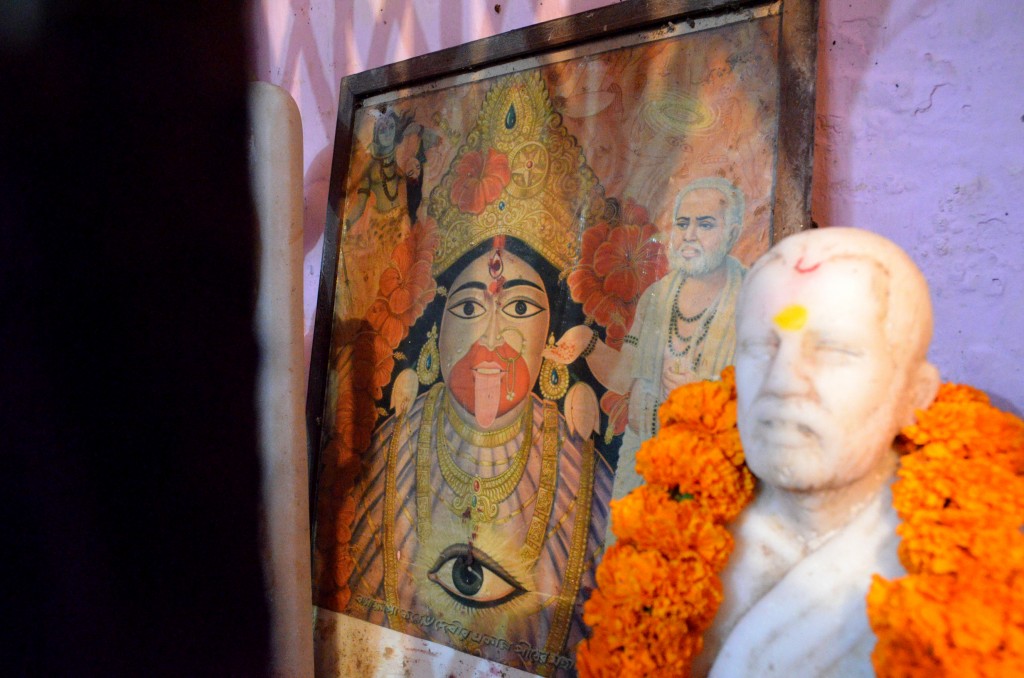
An image that shows Ma Tara with an eye over her heart is prominently displayed in a temple known as the Dakati Kali Bari (“Bandit Kali House”) located in South Kolkata
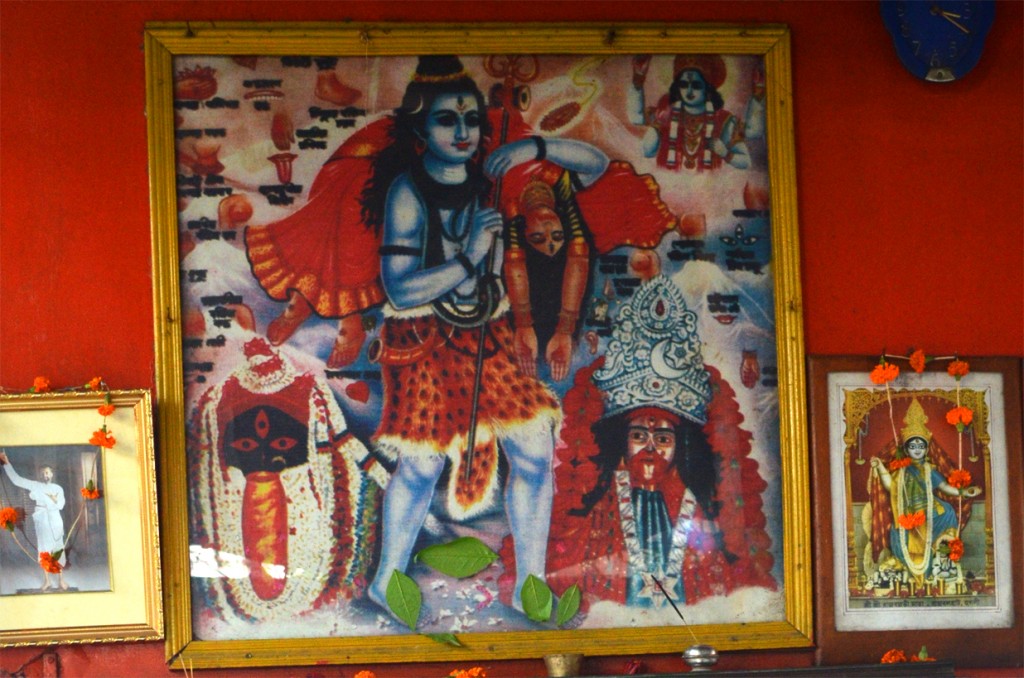
Hanging above a popular Kali shrine, this framed picture associates Tarapith with the third eye of Sati (Gariahat Road, Kolkata)
The Temple
The main mandir is a four-sided, marble block structure capped by a curved roof called a dochala, from which projects a smaller four-sided tower with it’s own dochala. I was immediately struck by the obvious similarities between the architectural style of the Tarapith Mandir and another famous Bengali shakti pith with which I am very familiar–Kalighat. These two buildings are roughly the same size and shape. In fact, many temples and even tombs (called samadhi) that you find in West Bengal share this same structural design the source which becomes apparent when visiting the villages of rural West Bengal. Structurally, it is the same design found in the simple architecture of the traditional Bengali hut–with its four mud walls and thatched roof–replaced with more lasting materials.
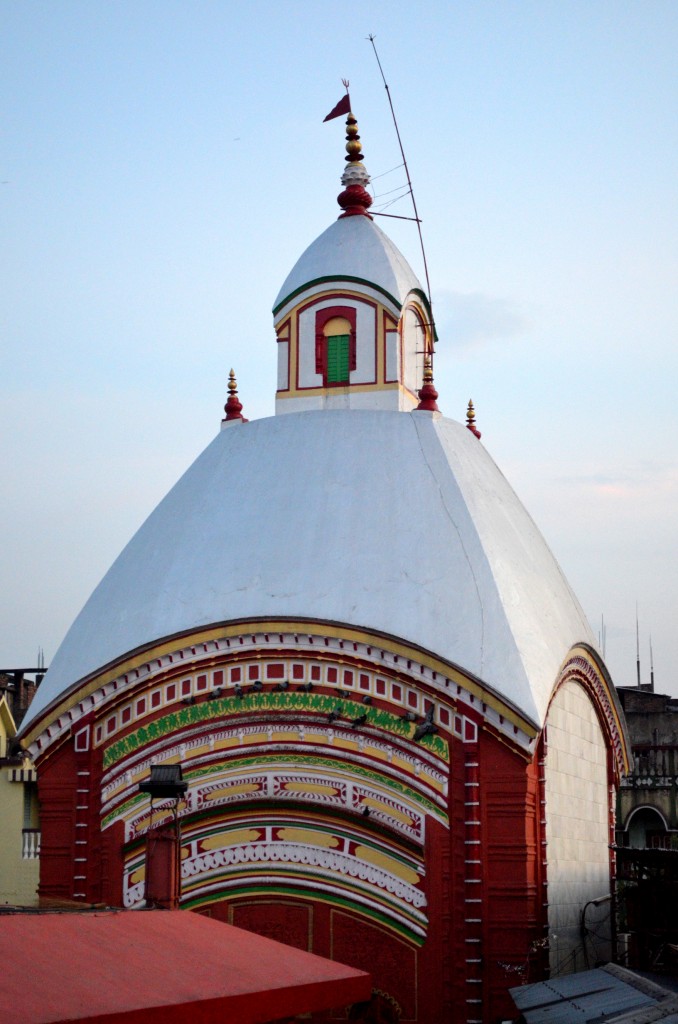
The Tarapith Mandir
The facade of the Tarapith temple is made of terra cotta and is embellished with scenes from various Indian epics. Its central relief depicts the goddess Durga slaying the buffalo demon Mahishasura. Three archways lead one toward the sanctum sanctorum’s double door upon which ornate metalwork beautifully displays reliefs of Tara’s sacred flower (the hibiscus), chakra motifs, and portraits of Shiva and Tara on opposite sides. Above this entrance is another metal relief sculpture of Lord Shiva with eyes closed, flanked with sacred swastikas and framed by an elegant repeating hibiscus pattern.
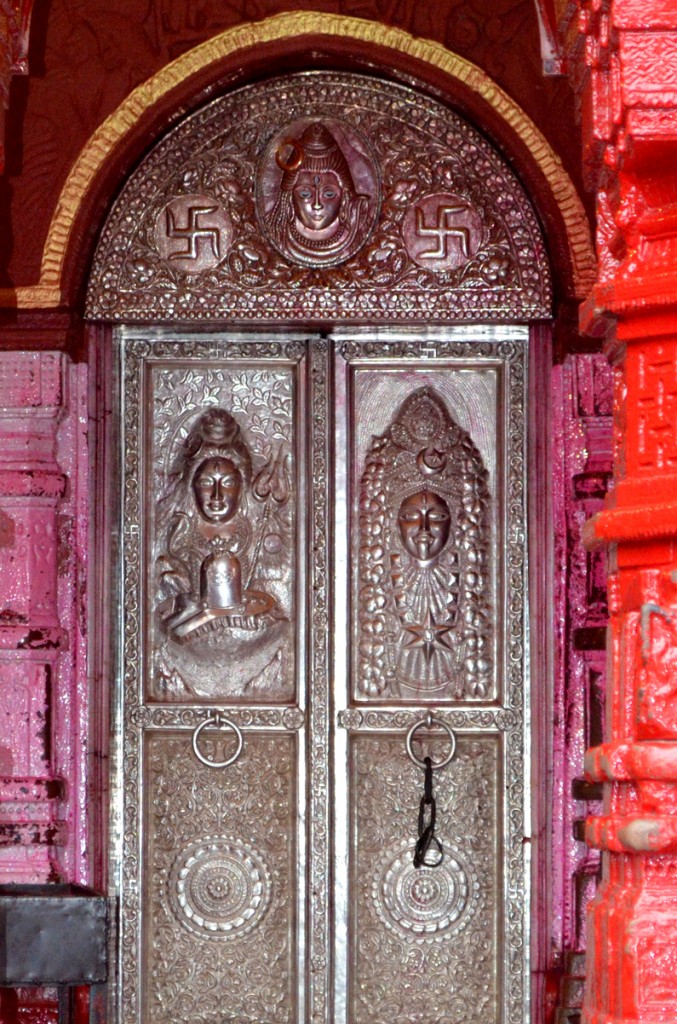
Elegant metalwork ornamenting the main temple gate
Ma Tara’s sacred murti (divinely-empowered image) is spectacular to behold. Her mask is made of silver and its finely-crafted face is graced with three eyes. These eyes look northward except during an annual festival when the entire murti is placed in a nearby “resting temple” located mear the main mandir. On this special occasion only, Ma Tara faces west, overlooking the cremation ground. The murti’s mouth is smeared with red sindoor (vermilion) paste in a manner resembling blood, and she has a long protruding tongue. Her tongue is also covered in red pigment, but at its tip, silver is exposed as the sindoor gets worn away from the many offerings of whiskey fed to Tara on a daily basis. Priests pour the liquor into a small vessel which is then offered to the goddess by holding it up to immerse her tongue. A mixture of liquor, water, and sindoor that has been offered to the goddess is considered especially sacred. I was offered a taste of this prasad during my last visit by a friendly priest who referred to it as the goddess Tara’s bathwater.
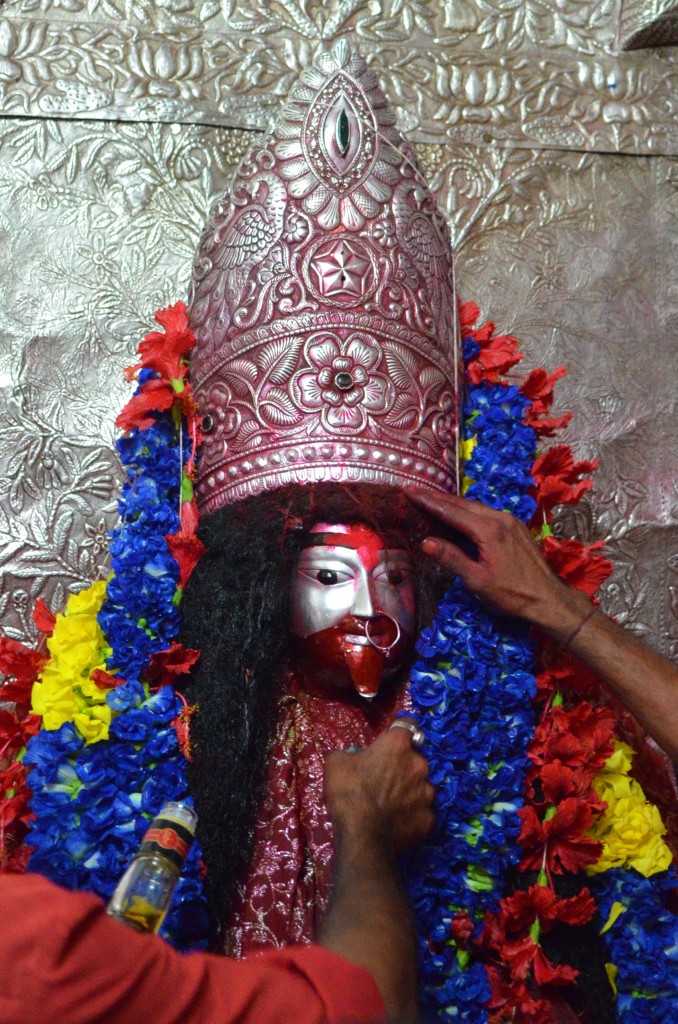
Ma Tara receiving offerings of whiskey
Tara Ma’s murti also has a luxurious mane of matted locks made from what feels like human hair. Atop this rests a very large, ornate crown adorned with a five-petaled hibiscus flower as well as a pentagram. Judging by various calendar art prints and photos of the murti, this crown has undergone various alterations as it is periodically crafted anew by artisans. Despite these changes, the motif of a star persists. The star symbolism is most likely an allusion to the name “Tara,” which in Sanskrit means “star.”
Although this representation of the goddess is certainly the most renowned, concealed within it is the far more ancient adi rup—the original stone form of the goddess Tara that has been worshiped at Tarapith for countless centuries. According to some myths surrounding Tarapith, this particular rock formation is the goddess Sati’s third eye which fell to the earth ages ago and landed in the cremation ground where it turned to stone. The adi rup’s shape is said to reveal the goddess in her maternal aspect, cradling and suckling Lord Shiva like a baby. From my personal observations, it appears to be no more than a big, indistinctive rock. However, with some imagination I found it was possible to visualize the image of Tara suckling Shiva superimposed over its bulges and recesses, but admittedly this was quite abstract.
Tara’s original stone form is available for darshan when the temple first opens at 4:00 a.m. The purohits I spoke with referred to the early morning ritual as the snan puja. Snan is the Bengali word for “bathe” and this no doubt refers to the ritual procedures I observed where the stone form of Tara is washed with water (mixed with alcohol and other sacred substances) which is then collected as prasad. Although I was able to snap a few pictures of the masked Tara murti, I was yelled at when I tried to photograph the adi rup. It seems that even though the well-known, masked form of Tara receives the most attention and ritual worship, the ancient stone image at its heart is accorded even greater reverence. Revealed for a short period of time, Tara Ma’s adi rup is again concealed underneath clothing and transformed into the body of her more widely known masked form before the morning aarti begins at 6:30 a.m.
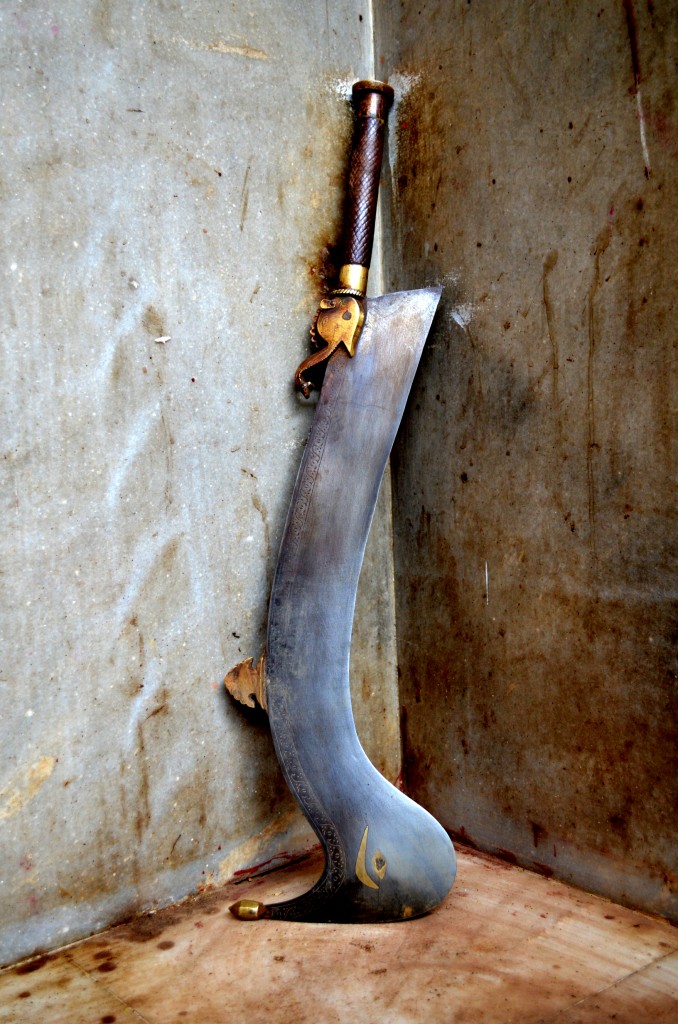
The impressive ritual khadga used at Tarapith
Animal Sacrifice
A short distance directly across from the garbhagriha (literally “womb chamber”), is the temple’s sacrificial area containing a single harikhat. It is here where goats are offered to goddess Tara who is said to enjoy blood sacrifice . I spent some time at this place and watched as the karmokar (a Bengali word meaning “blacksmith”) beheaded goats on numerous occasions. Speaking with this man, Braja Gopal, I learned that these sacrifices are a daily occurrence at the Tarapith temple and before him, it was his father who performed the rite. This naturally intrigues me; questions like “How many generations of your family have done this work?” and “Why is a blacksmith entrusted with beheading goats?” immediately arose in my mind. These and many other questions that I have can only be answered with further research.
The khadga (ritual decapitation sword) used at Tarapith is the most beautifully crafted sword of its type that I have ever seen. Traditionally a khadga blade is made of iron and at Tarapith this is augmented with brass embellishments along with a beautiful hilt that has an elephant head motif. The sword’s design is that of the top-heavy, curved blade commonly seen in icons of fierce goddesses like Kali, Tara, Chinnamasta, and others.
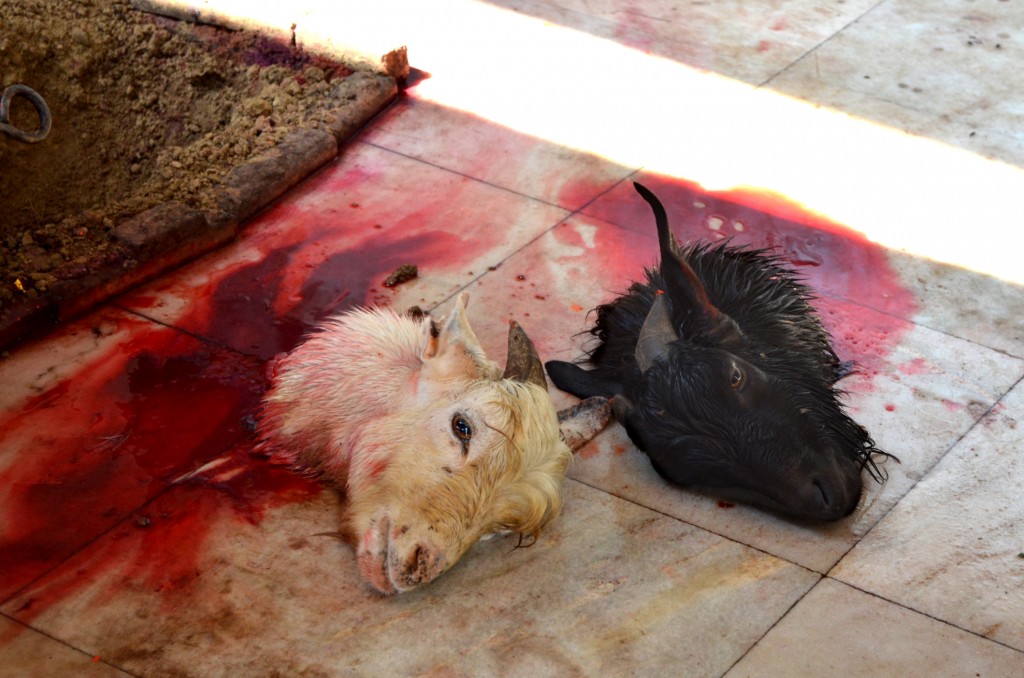
“She who enjoys blood sacrifice”
While exploring the complex I noticed that if there were no objects or masses of people present (as is usually the case), the harikhat would be directly in Ma Tara’s view as she oversees the affairs of the temple. In her hymn of one hundred names taken from the Mundamala Tantra she is given such epithets as, “She who is smeared with blood,” “She who likes blood,” and “She who enjoys blood sacrifice.” There can be no doubt that the alignment of Ma Tara’s eyes with the harikhat is intentional, for her power is not confined to the sanctum sanctorum. The entire temple complex, cremation ground, and surrounding village belongs to the goddess Tara. For devotees, she is not a localized phenomenon, but omnipresent creative and destructive force. Ma Tara is shakti, or power itself; as an Aghori told me in the cremation ground, she is the “world-in-charge” mother of all existence.
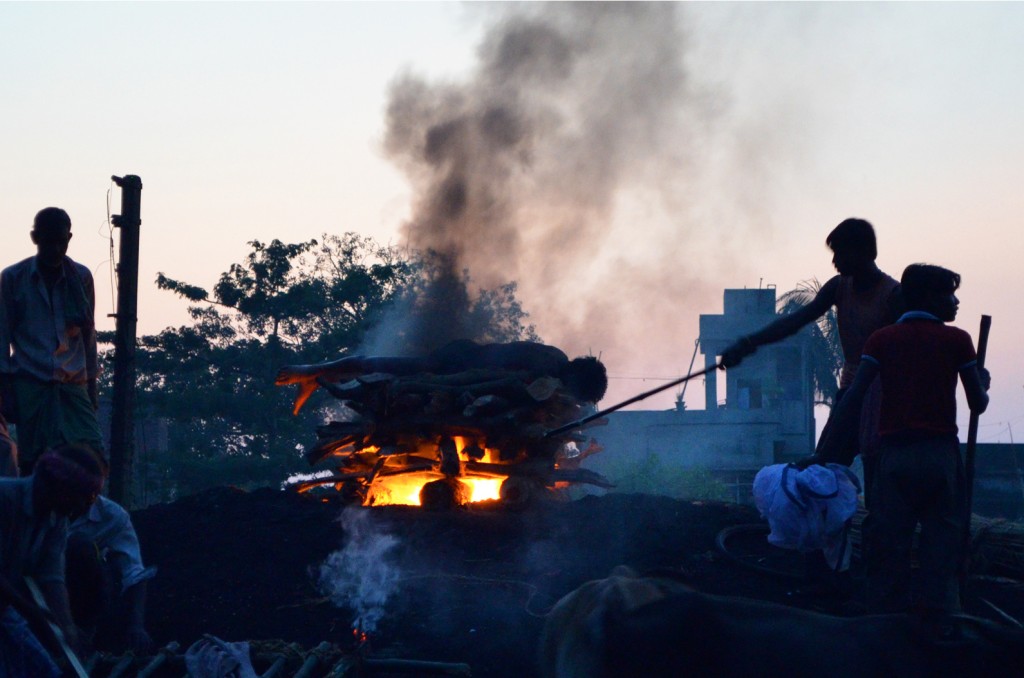
The burning ground at twilight
The Mahasmashana:
Tarapith’s Great Cremation Ground
Entering through the main gate and descending a staircase, Tarapith’s Mahasmashana (Great Cremation Ground) welcomes you with beggars grabbing at your legs and hawkers competing for your attention while trying to peddle their wares. Incense and candles are sold here along with the red sindoor and alta (pigment powder and liquid dye) which is offered to the stone form of Ma Tara’s feet (commonly referred to as Tara’s footprints) located at an important shrine in the burning ground. Looking about, one will immediately notice small hut-like structures made of concrete. These are tombs, called samadhi, and they mark the graves of various spiritual adepts, tantriks, and mystics. The most prominent of all is a large red samadhi–very close to the main entrance–marking the burial place of Bamakhepa’s (the famous tantrik “madman” of Tarapith) mortal remains. This samadhi, the most revered in all of Tarapith, receives ritual offerings throughout the day and night. It is here that the majority of pilgrims making a trip to Tarapith’s cremation ground come to pay homage to the spirit of the “mad saint” Bamakhepa.
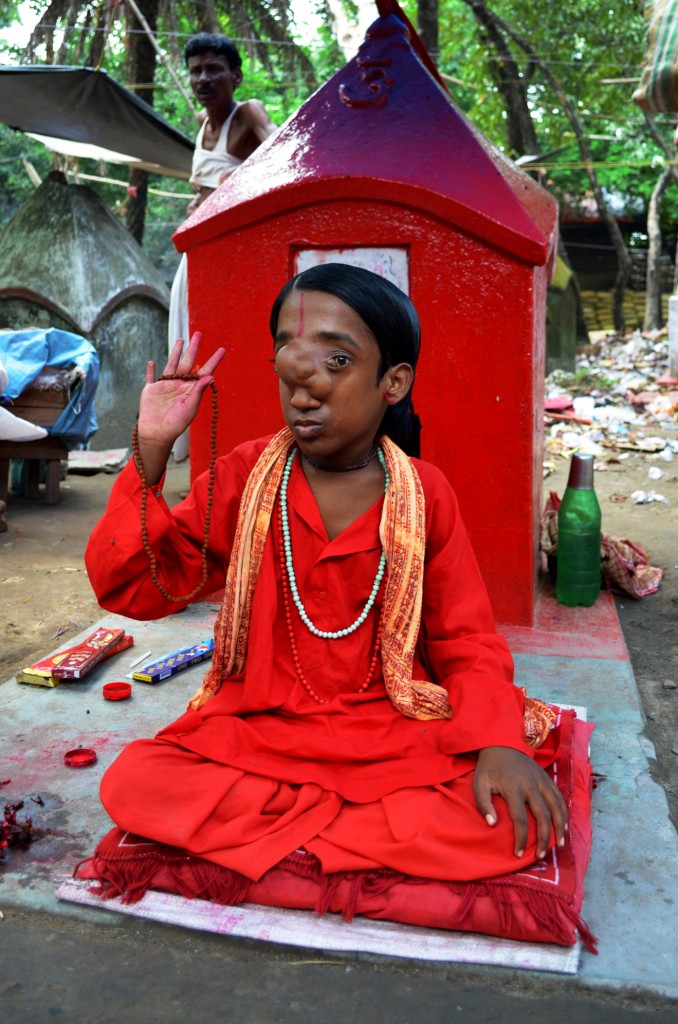
Ganesh Baba offers his blessing to visitors who arrive during the day
Venturing past the many tombs, one comes upon a scattered hutment. Despite the Tarapith Mahasmashana’s somewhat sinister reputation—considered a place of death haunted by ghosts and demons—a number of tantriks have chosen to reside here, making the cremation ground their home.
The simple structures they inhabit are constructed using local materials. They are usually built using sandbags for the steps and foundation, bamboo poles as the frame and door, packed mud for the floor and walls, along with a thatched roof. Most are only basic enclosures large enough for a sleeping area, personal altar, and sacred fire pit, although this is not always the case. When I first visited in 2003, I was invited inside the cremation ground’s largest “hut” by a tantrik named Mani Baba, who had built it with his guru more than five decades before. Here I was shown a full temple room that houses a large Shiva lingam and had 108 human skulls lining its four walls.
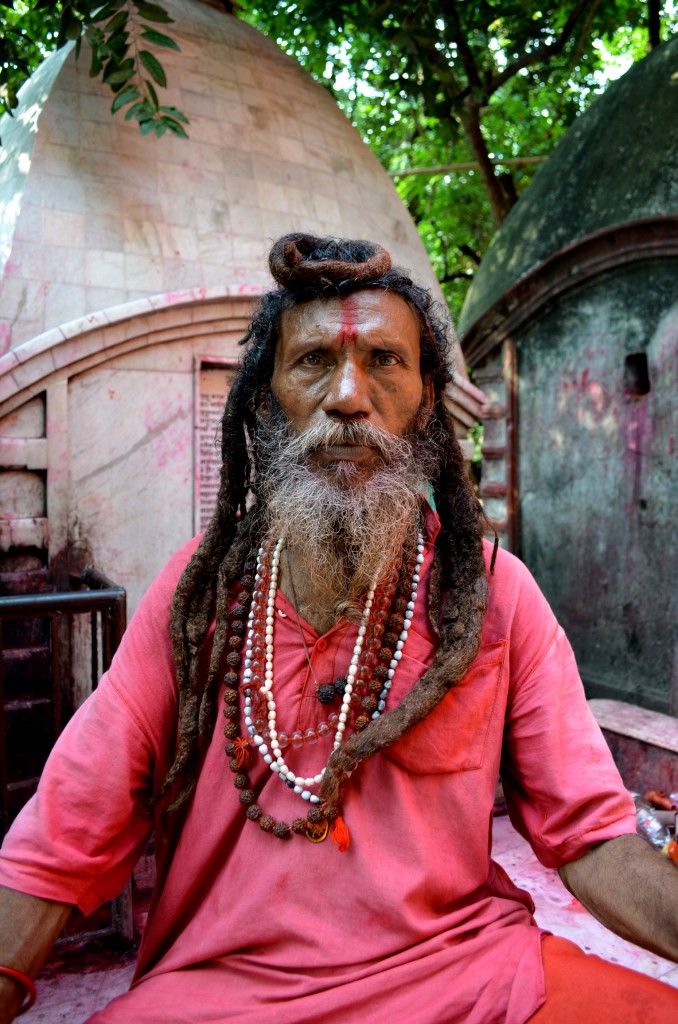
A Tantrik Sadhu
Magic is a powerful, living force at Tarapith and the cremation ground culture is a vital component of that magic. From the red-clad social outsiders to the sincere tantrik sadhakas, there is a wide range of spiritual and not-so-spiritual practices taking place within its boundaries. I have had some good fun drinking alcohol with a tantrik folk-music singer that I was recording and have also chanted mantras with Aghoris who were performing a fire ritual spanning several days. Like the goddess Tara Ma herself, the power of the burning ground is ambiguous and liminal, so it follows suit that the approaches to Tara Ma cover a broad devotional spectrum. Regardless of the different forms their spiritual expressions may take, all who dwell here consider themselves sincere bhaktas of the goddess Tara Ma and feel an intimate connection with her.
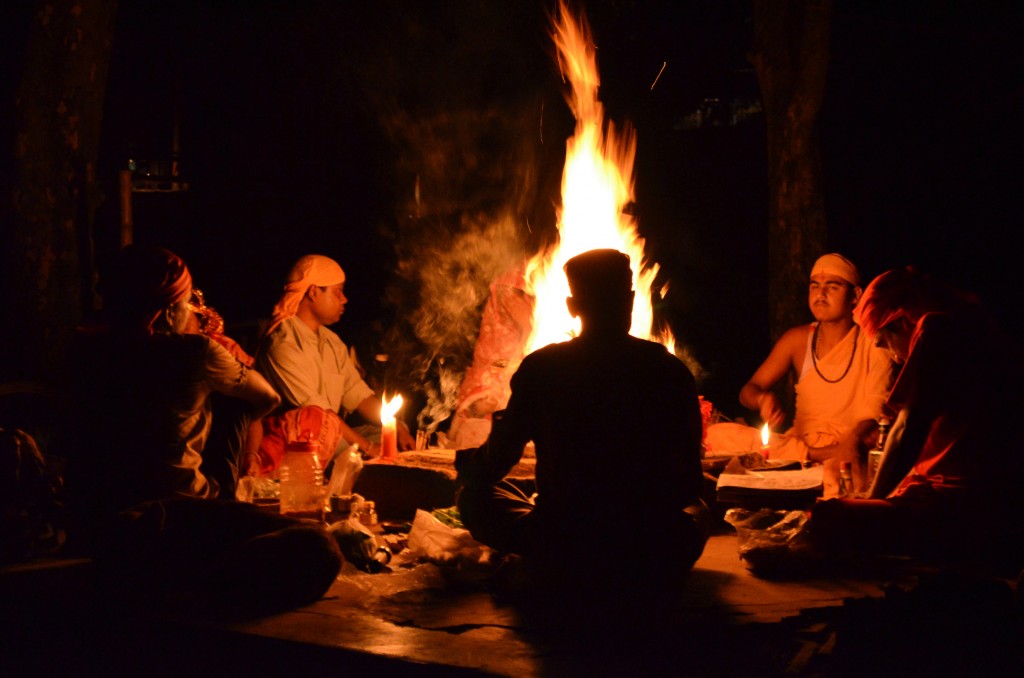
Fire rituals are performed throughout the night
Following a dirt path that weaves through the length of the cremation ground, one comes upon a veritable hill of human ash mixed with wood and bone fragments located at the top of a ghat on the east bank of the Dwarka river. This is the funeral pyre proper: the specific area where human corpses are placed upon piles of wood which are then set alight. It is a daily occurrence at the Tarapith Mahasmashana and I have personally seen up to three pyres burning at once. According to Hindu dharma (cosmic order), cremation is the final rite in the course of an individual’s existence which helps the soul along in its quest for liberation. It is a ritual that affirms non-attachment to the body, which having temporarily served its purpose as a vehicle for the spirit, is now no longer needed.
When observing the activities occurring at this burning place, it becomes apparent that quite often bodies brought here are not burned. This is because a lot of the corpses arriving at Tarapith come from impoverished villagers who cannot afford the wood used to build the requisite pyres. This sometimes results in other materials being used for fuel such as garbage and bicycle tires. However, many of these poorer people are simply not cremated, but rather interred within the hallowed ground of the Mahasmashana–buried in graves dug by the Dom with the aid of small shovels. Thus when one walks about the great cremation ground, one is in fact walking over the remains of countless bodies that have been buried here over the centuries; the entire Mahasmashana is effectively a large graveyard. So many bodies have been buried at Tarapith that it is not uncommon to find human bones, which have been dug up by dogs, scattered throughout the Mahasmashana.
Cremations at Tarapith are not gentle affairs. The piles of wood used are often very small compared to other burning grounds I have visited—like Manikarnika Ghat. Since the pyres aren’t very large, the process of burning a corpse is adjusted accordingly. During my last week-long stay at Tarapith, every body-burning involved the corpse being laid face down on top of the pyre with the flames concentrated at its torso. The stretcher which carries the body to the burning ground is disassembled by the Dom who make use of its bamboo poles. These are not only used to tend the fire, but also to beat and break the body down, folding it in upon itself as it burns in a long and aggressive process. When the head has sufficiently burned, a bamboo pole is raised aloft and an emphatic “Jay Ma Tara!” (“Victory to Ma Tara!”) is shouted before the pole comes crashing down with enough force to break open the skull. According to belief, the dead person’s soul is released upon this cracking of the skull.
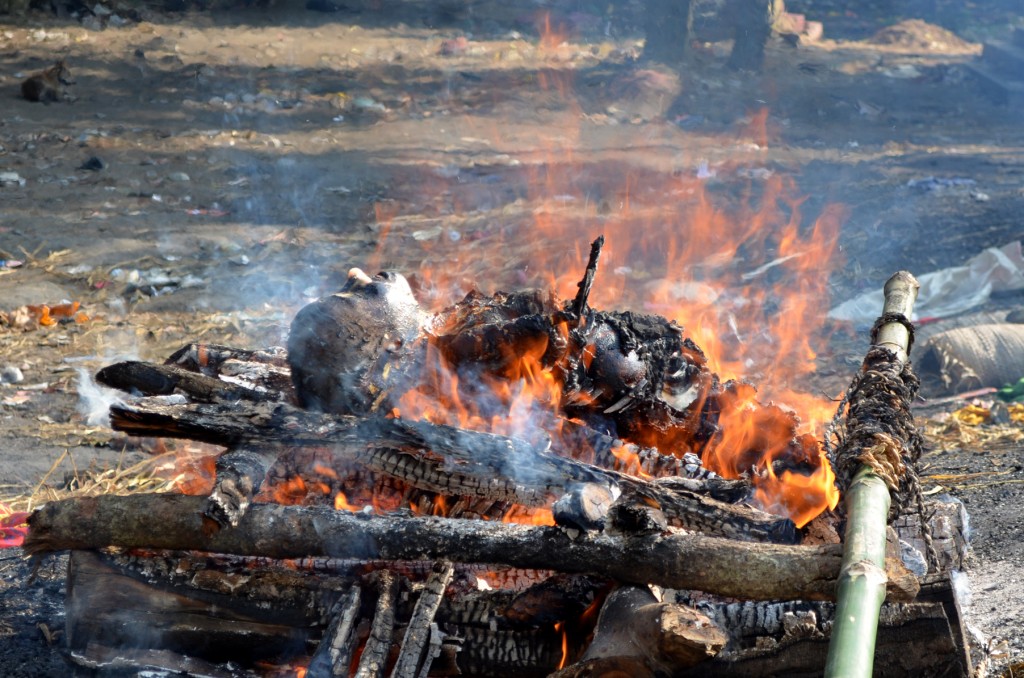
In Tarapith’s Mahasmashana, the worlds of spirit and matter combine
The status of Tarapith as a powerful siddha pith—a place where one can achieve enlightenment or gain various supernatural powers—is inextricably bound with this conception of the cremation ground as a liminal zone: the Mahasmashana is perceived as a nexus point where the physical and spiritual worlds intersect. Within this ultimate place of transformation, rituals and sadhana are believed to yield faster and more powerful results. It is said that by performing his sadhana in this very cremation ground that the”mad saint” of Tarapith, Bamakhepa, achieved an enlightened state of consciousness when he was granted a vision of Ma Tara dancing upon a burning corpse.
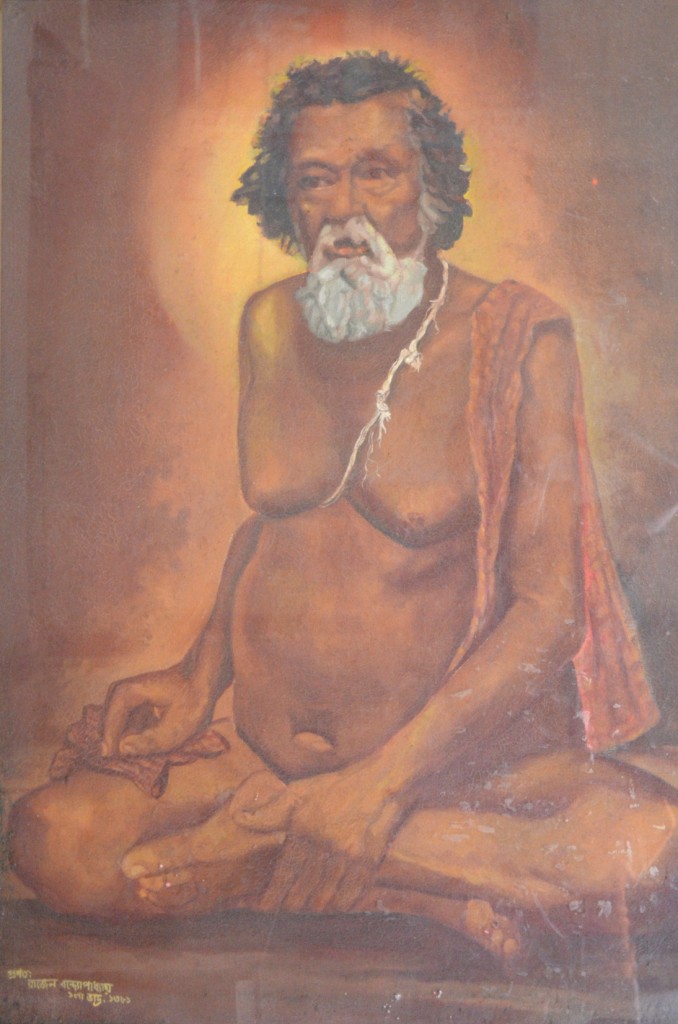
Portrait of Bamakhepa
BAMAKHEPA: THE MAD SAINT OF TARAPITH
Bamakhepa (1837 – 1911), the famous “mad saint” of Tarapith, was born Bamacharan to a Brahmin family in the small village of Atla Gram, located a short journey west of the Tarapith temple. From a very young age, he worshiped Ma Tara with an unbridled enthusiasm that earned him the nickname of Bamakhepa. Khepa, a word which translates as mad or crazy, is also used as a honorific title among tantriks and Bauls. When used in this way, the word khepa refers not to the ordinary insanity associated with mental illness, but to “God Intoxication,” the divinely inspired madness toward which all ecstatics ultimately aspire. The word bama simply means “left.” So combined together, the words bama and khepa connote one who has attained a state of divine madness through the left-handed practices of tantrik sadhana. If the stories that continue to be told of his bizarre spiritual life are accurate, Bamkhepa can truly be said to have been a holy madman.
Many extraordinary legends surround the strange behavior of Tarapith’s most beloved saint. He dwelt in a haunted cremation ground where he meditated by gazing upon burning corpses while smoking ganja and drinking alcohol out of human skulls. However instead of merely getting intoxicated from these substances, Bamakhepa was said to have gained supernatural powers through his unique form of spiritual practice which involved these “polluting” substances. People speak of how he could handle venomous serpents with ease and would hand-feed Bengal tigers offerings collected from the Tara Temple.
One story that I heard about the saint involves a man, suffering from elephantiasis of the scrotum, being brought to Bamakhepa as a last resort. Frustrated at his meditation being interrupted, Bamakhepa pounced upon the man, choking him and spitting in his face while shouting about how this man brought the condition on himself through negative karma. As shocked onlookers struggled to pull the saint away, Bamakhepa kicked the man in the groin. Miraculously, the very next day the man was completely cured of his condition. The once-afflicted man then became a dedicated disciple of the mad saint!
Popular images of Bamakhepa depict him sitting cross-legged in Tarapith’s Mahasmashana, complete with blazing fires and human bones strewn about, meditating while surrounded by ghouls and jackals. Through his unorthodox practices, Bamakhepa is said to have achieved a non-dual state of consciousness where he came to perceive all things as a sacred continuum that was an expression of Ma Tara’s infinite power.
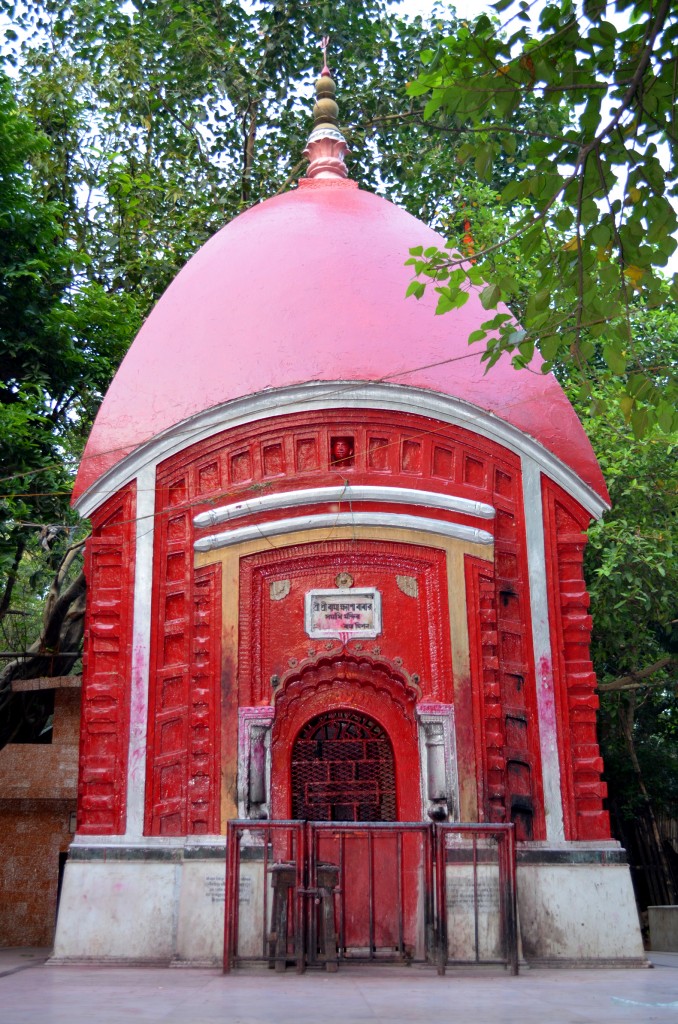
Highly-venerated samadhi of the mad saint, Bamakhepa
Although during his life Bamakhepa travelled to places such as Varanasi, Hardwar, and Kolkata, he always returned to the Tarapith cremation ground which was his true spiritual home. His presence is still very much felt here as it will undoubtedly be for a long time. When he left his body in 1911, Bamakhepa’s corpse was buried in a seated, cross-legged position near the entrance of the burning ground. Above this spot there now stands a large, red samadhi that receives daily ritual worship with burning candles, incense, and prayers offered by the many pilgrims and sadhus who visit the sacred burning ground as a fundamental component of their spiritual journey to the temple.
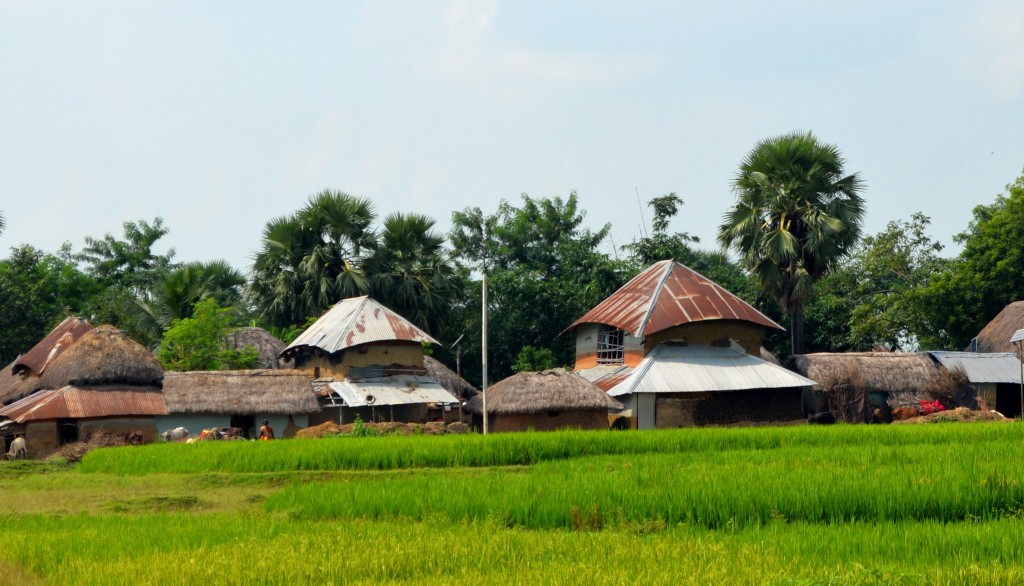
Approaching the village of Atlagram
The nearby village of Atla Gram, birthplace of Bamakhepa, can be reached in about twenty minutes by van. In this case, “van” refers to a specific type of cycle-drawn cart which you find in the rural areas of West Bengal. First, one crosses a bridge over the river Dwarka and then it is a pleasant cruise through long winding roads cutting across the vibrantly green, expansive rice paddy fields of rural Birbhum District. One cannot help but be struck by how overwhelmingly quiet everything feels, especially after experiencing the hustle and bustle of an active temple and even more so if you are used to life in a big city like Kolkata.
Entering through the main road which leads into the village, one immediately sees a bright pink mandir dedicated to Bamakhepa, called the Shri Shri Bamdeb Smriti Mandir. Across the road opposite this is a sacrificial harikath. Entering this mandir one sees a white Bamakhepa statue sitting cross-legged. To the left of this is an enshrined painting of Bamakhepa and to the right is a white Shiva lingam above which hangs an old painting depicting Tarapith and various scenes from the saint’s life.
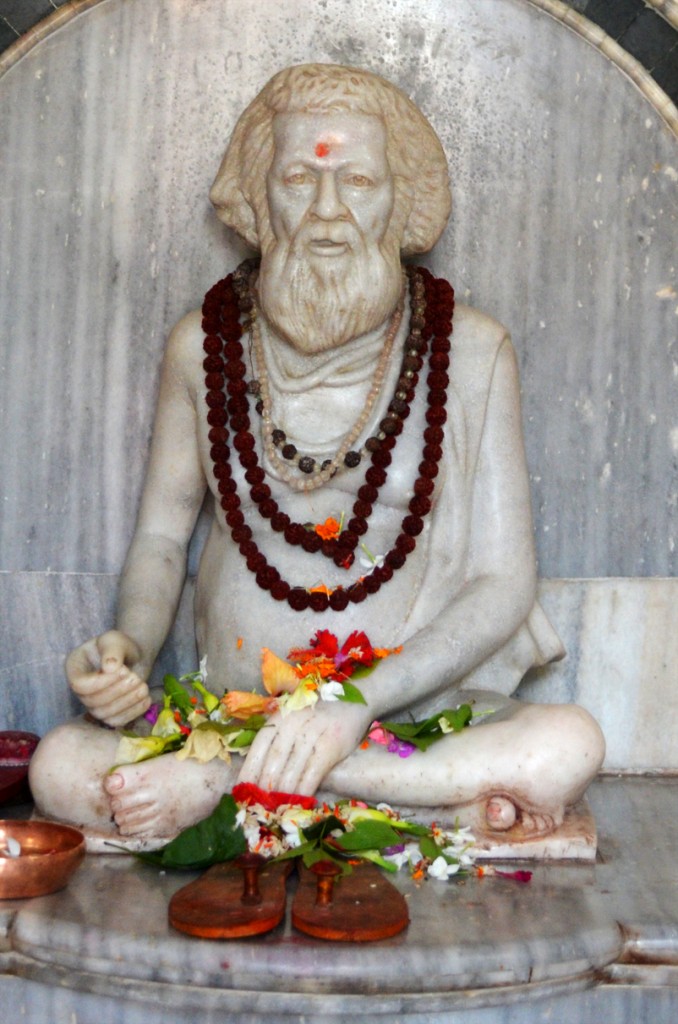
White stone murti of Bamakhepa which is housed at the Shri Shri Bamdeb Smriti Mandir
Adjacent to this mandir is the place where Bamakhepa was born—a small room in a home that has since been converted into a temple. Today it is presided over by the grandson of Bamakhepa’s younger brother, Mr. Umanath Roy, and his extended family. This temple room contains two white statues of the saint, along with a framed image of the Ma Tara temple murti, and is decorated with dozens of pictures of various Hindu sadhus, tantriks, and mystics famous across India.
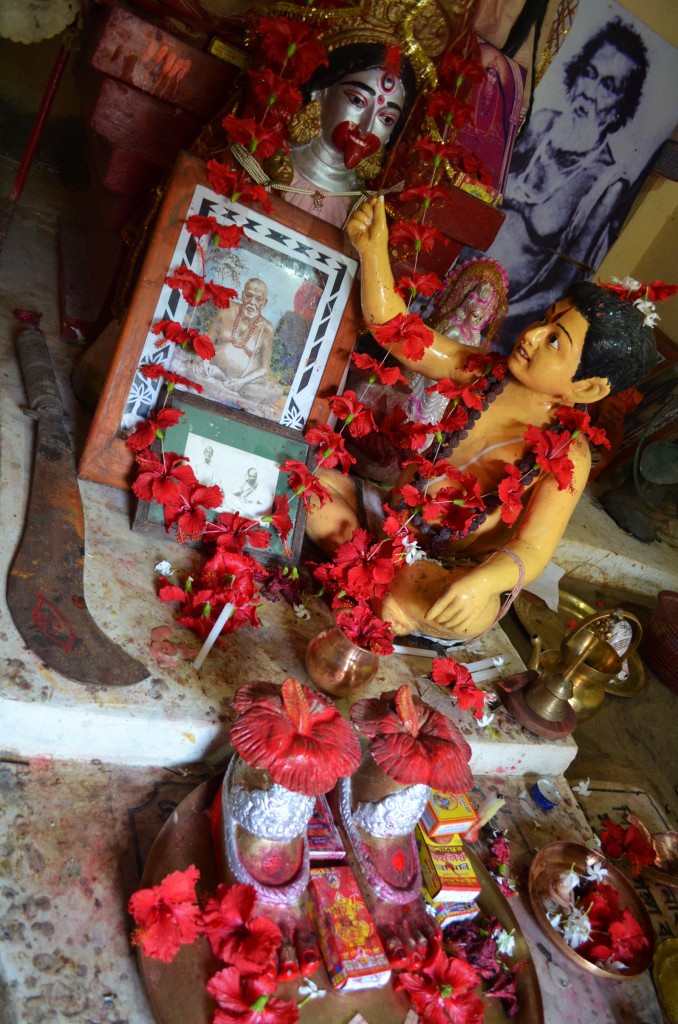
Bamakhepa (as a young boy) attempting to feed the murti of Ma Tara
This small village was the place where Bamakhepa grew up and his childhood home is open to visitation. It naturally contains another shrine along with a wall mural depicting the goddess Tara. We were then led around back to see the small temple where Bamakhepa used to conduct rituals for his family. Here you will find a statue of the goddess Ma Tara flanked by two large pictures of Bamakhepa. Next to her is a Shiva trident. Most interesting to me was the smaller statue of Tara that is being “fed” by another statue of Bamakhepa as a boy. This image is one that would be recognizable to anyone familiar with iconography of the “mad saint” and his legendary unusual behavior. He would often try to feed the murti of Tara Ma by hand and then throw fits when she would not eat, rolling around out the ground while crying out to the goddess. At various temple marketplaces where I have seen this type of image in the form of calendar-art prints and framed dioramas, Bamakhepa is always shown as an adult, but the sculpted murti here uniquely depicts him as a child.
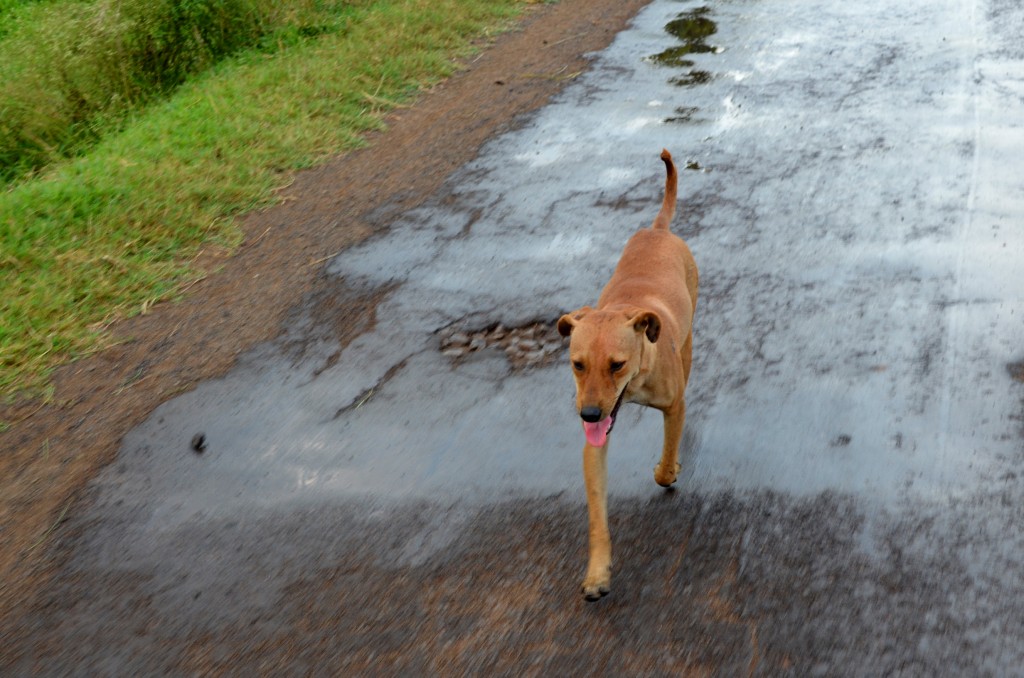
Wild dogs are often depicted as the companions of Lord Shiva
I would not feel that an account of my trip to Bamakhepa’s birthplace would be complete without also mentioning the circumstances surrounding our journey there. My assistant Julie and I asked a friendly Aghori woman, Gouri Ma, to accompany us on our trip to this sacred place. While discussing our travel plans with her in Tarapith’s cremation ground, a stray dog seemingly took notice of our conversation and made his presence strongly felt by rubbing against all of us. This dog then proceeded to follow us as we walked to the main road and arranged our ride. Bamakhepa himself is said to have been an avatar (divine incarnation) of Lord Shiva and was called such by none other than Ramakrishna Paramahamsa. Dogs are traditionally associated with Lord Shiva and cremation grounds, so this all seemed rather auspicious.
Events took an even stranger turn when this dog proceeded to follow us on an extraordinarily hot day, running through the countryside, racing alongside our rickshaw for over twenty minutes without rest. He waited patiently as we explored the sacred place of Bamakhepa’s youth and then again ran with us as we journeyed back without so much as stopping to take a drink, or eat the biscuits Gouri Ma would periodically throw to him. When I asked Gouri Ma what she thought of all this strangeness, she looked at me smiling and emphatically replied “Rup!” implying that this dog was a “form” of Bamakhepa; in fact that it was a manifestation of the “mad saint,” at least in that moment. For her it was a sign that this event was meant to take place and given the tone of such a day, Julie and I could not help but agree with this attribution. I then snapped a photograph of the dog as it was following us, at Gouri Ma’s request.
Field Recordings
10/3/11
This recording was captured in the Tarapith Mahasmashana in the early morning hours. Two men were singing devotional songs and keeping rhythm with a khol drum, kartala (hand cymbal), and ghungur (ankle bells). The following song was performed upon my request.
10/4/11
Within the temple complex there was much activity taking place during Durga Puja. I had a chance to record this shehnai player accompanied by a small kettle drum played by a little boy.
Recordings from 2003
The next three tracks were recorded during my first trip to Tarapith.
In the first recording, you will hear the sounds of the evening arati at Tarapith from the location of the natmandir. I was seated cross legged on the platform directly in view of the goddess. You hear a martial rhythm played on a dhak while the temple bell loudly resounds.
These next two folk songs were performed in the Tarapith cremation ground by my Tantrik friend, Hashu Chattopadhay. He has since wandered on and I hope that he is still singing his songs somewhere in West Bengal today.
72 Comments
Trackbacks/Pingbacks
- The Sacrifice of Sannyasa | SEXY TO SWAMI - [...] share what I learnt as I ventured out to the nearby temple of my Ishta Devata – Tara Ma…

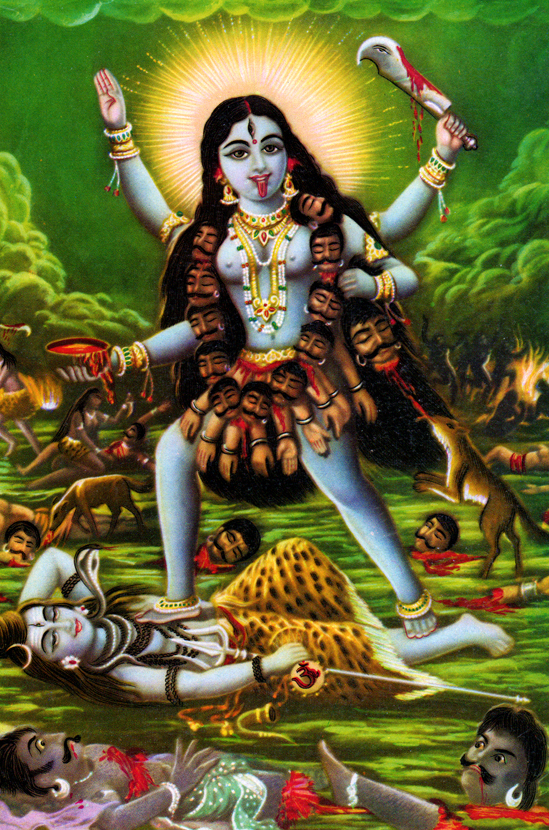
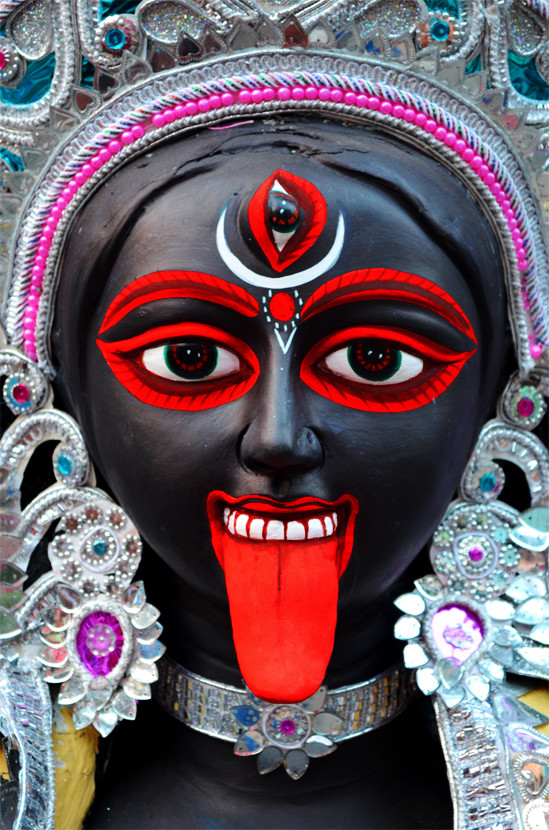
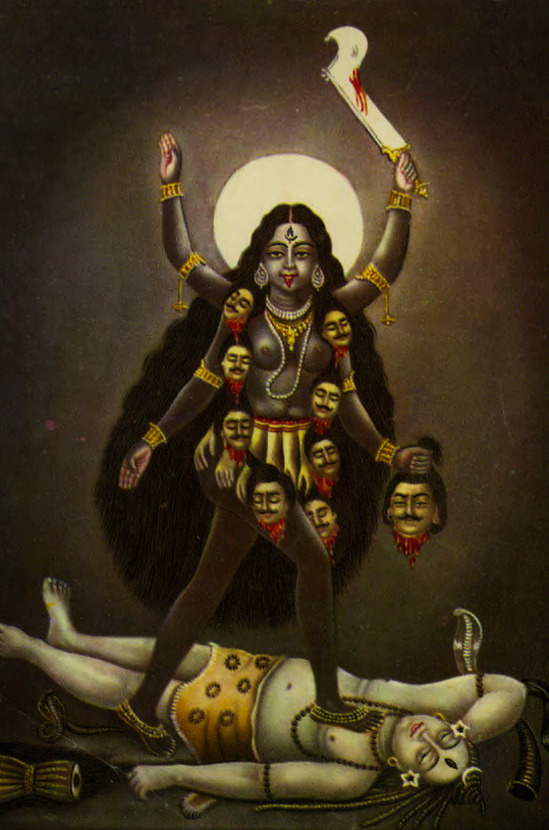
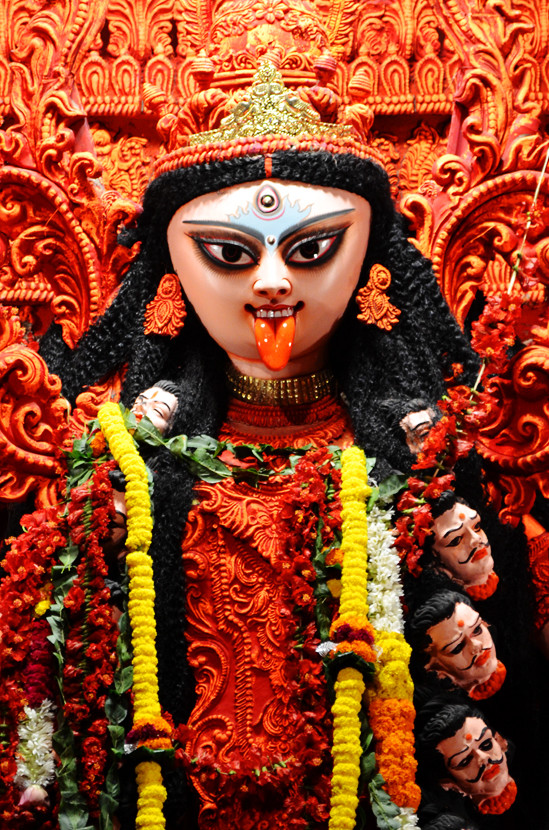
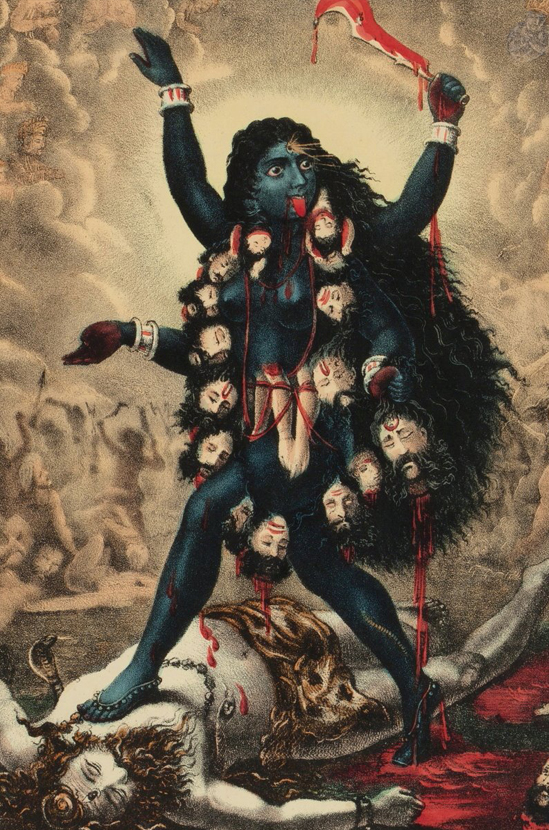
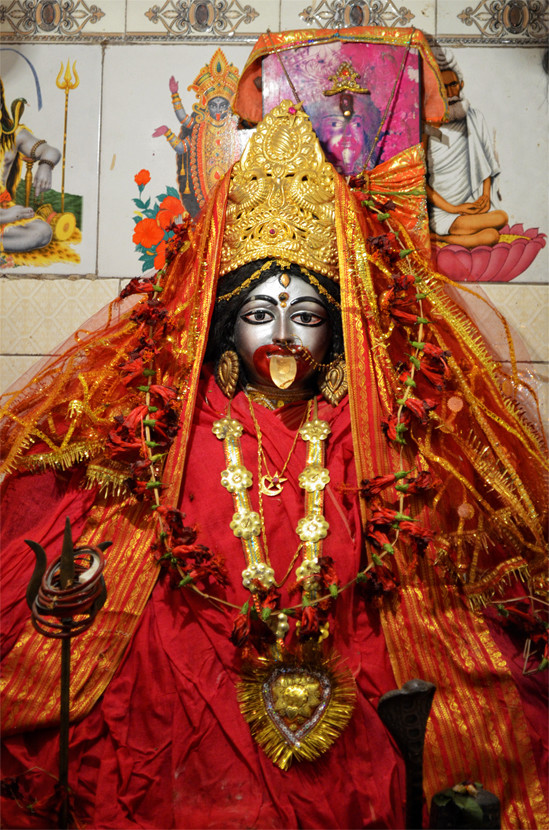
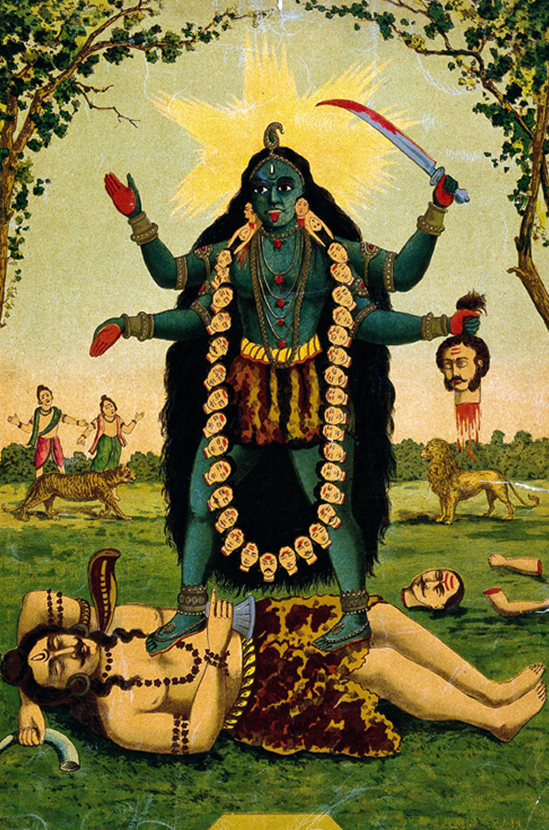
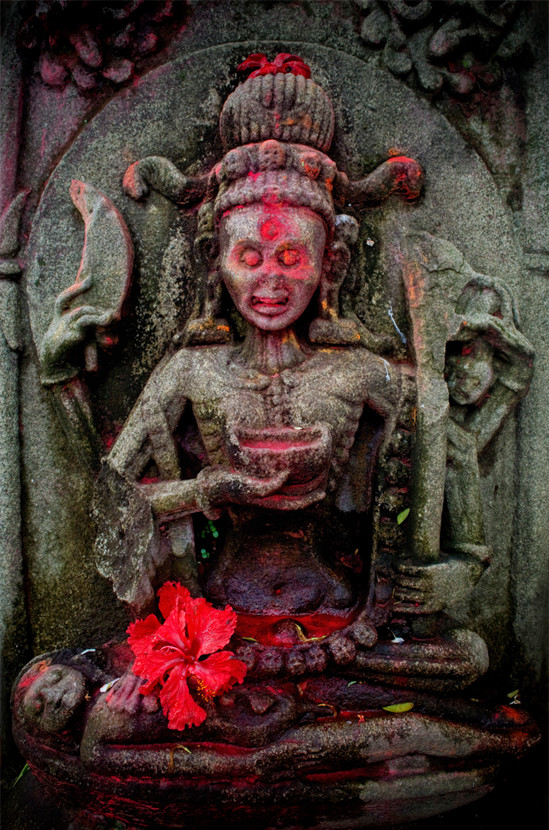
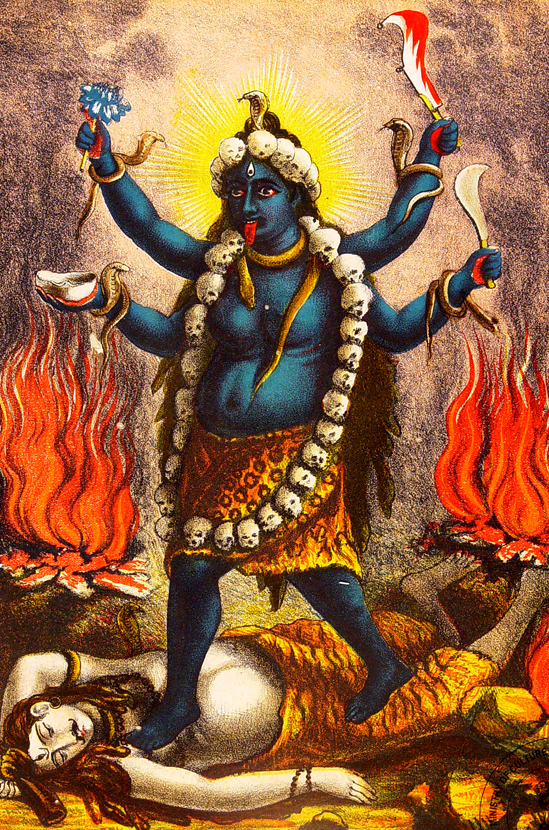
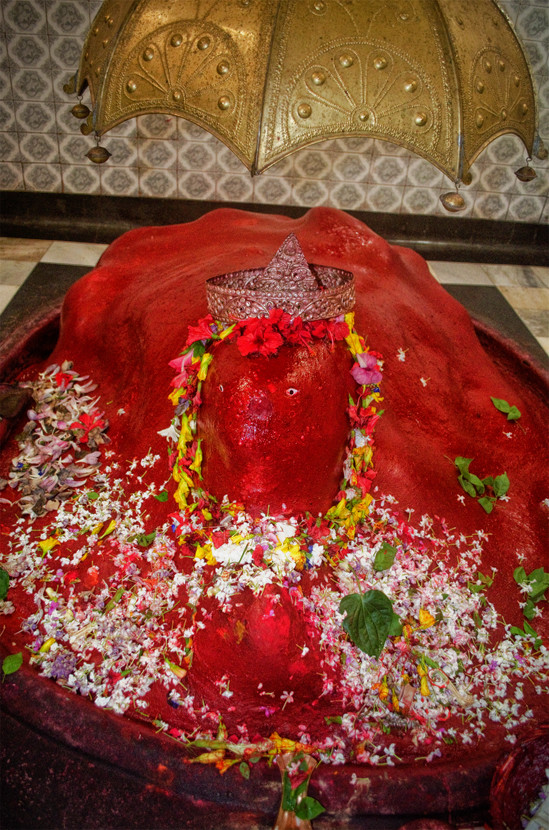
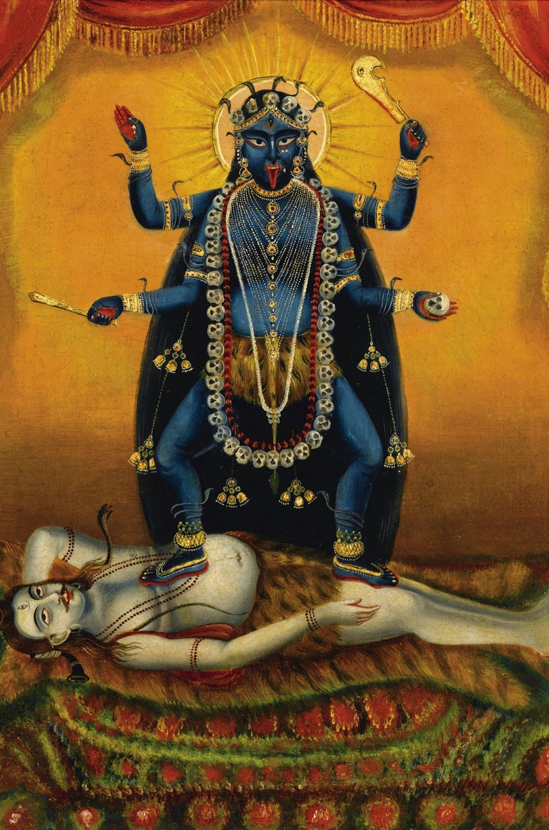
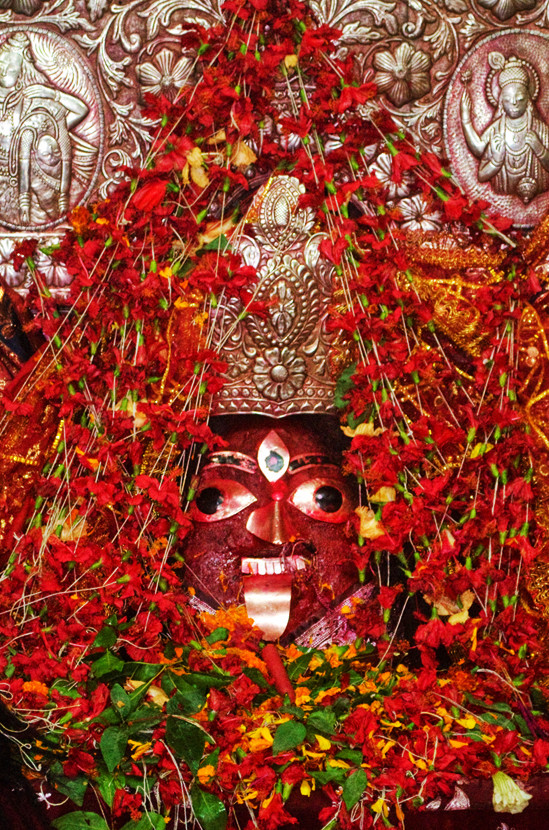
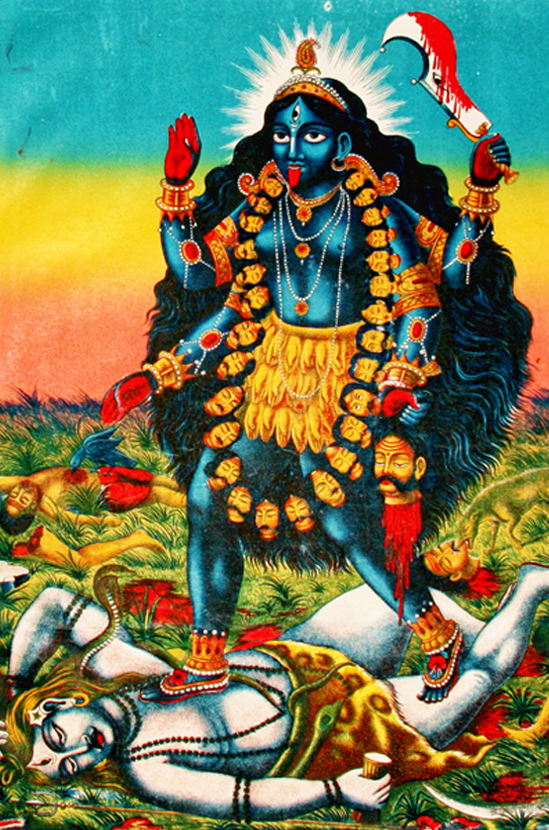
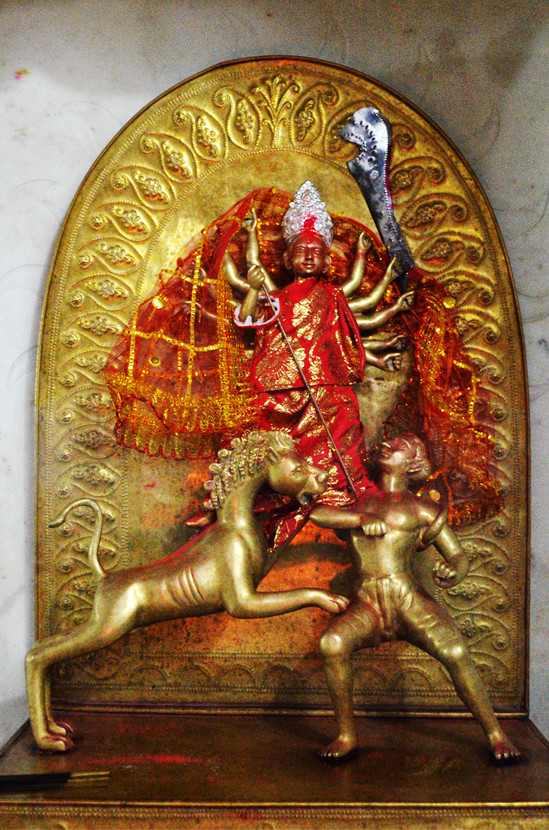
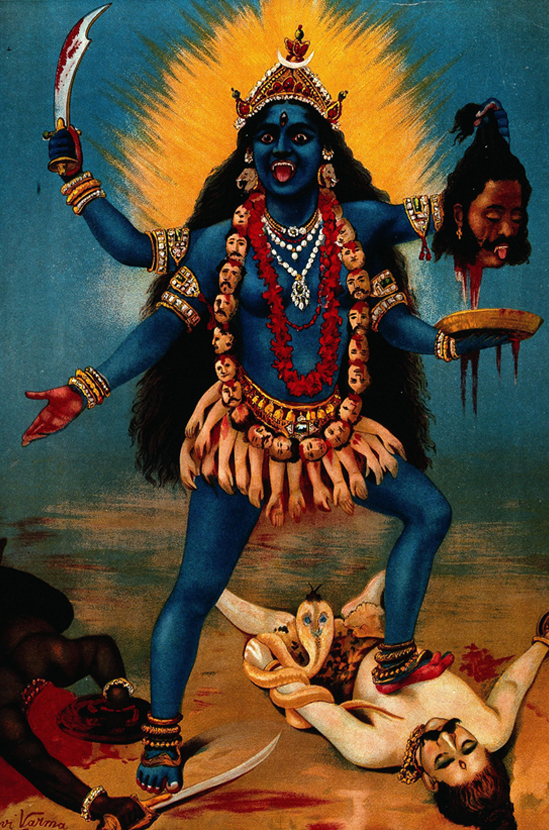
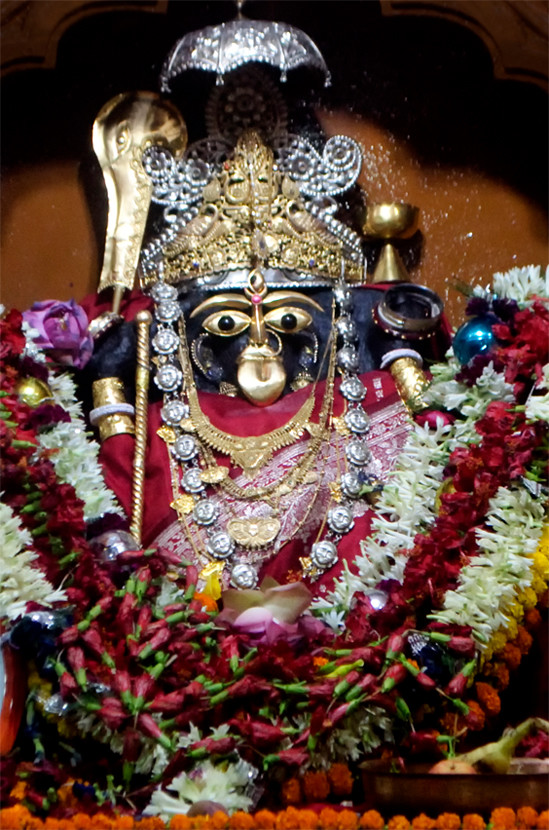
Thank you William.
Comment
Really u did a wonder work there… Its has superb reading experience.Good job done… Say as loudly as u can…. Joy taraa…. Joy Tara… Joy Joy taraaaaaaa……!!!!
What a photography! The snapshots seems live. Video and Recordings reached me to that Holy Place. “Maa tomake Pranam, Jay Tara.”
Recently it is publishing that here the third eye of devi Sati falls.And so many new Bengali films also showing the same.
But since my childhood I heard Tara Pith is a Siddha Pith by Bamdev.And old Bengali Cinema’s story is also based on that subject only.
I went Tara pith several times and talk with some old persons,pujari, Sadhu Baba and Tantriks; Most of them told us ‘Maharishi Basist dev’ first started ‘tapshya’ under the ‘Swait Simultala'(White Cotton Tree),located at Mahasmashana of Ma Tara. Dev Basist died and could not completed his ‘tapshya’ then he took a new birth as Bama khyapa (Janmantre Basist) and got Siddhi. That’s why it is a Siddha Pith of ma Shakti.
Hello, I’m planning to visit Tara pith in Jan 2013. Is it OK to visit the temple singly and stay there at nights? What care should I take? Please guide me.
Hello Shiva, please feel free to email me at kalibhakta@gmail.com with your specific questions. There are plenty of Hotels in Tarapith and finding a place to stay is not a problem. Just have a look at a few rooms and choose one that suits your needs–it’s pretty easy.
joy TARA,the description quiet beautiful though not exhaustive.Tara ma 2nd of ten mahavidyas depicts knowledge and light.She does not accept blood offerings and herself brahmamayi.
jai ma Tara………
jai ma tara
“Ma Tara of Tarapith” was indeed a good blog post and I
really was really happy to read the blog post. Regards-Deanne
Very useful data was given with real time match pictures. Thanks I visited Tarapith several times. Its nice place only for devotee who loves and respe t Maya Tara. The above article is very nice.
fanatic!!!
Jai ma Tara. Thanks for giving those data. It must be useful for us. Tara pith is a SAKTI PITH. MA TARA lives here. This place is very pure also very pleasant. Thanx.
Commentpranam tara maa
om nam sivay jaitara jaimatara
Joy joy tara joy guru bum.but dear where tara ma choran in Mahasamshan.
CommentJAIMATARASATRSATPRAMAMOR TARASADHAKBAMAKHEPAKOPRANAM KARTAHUN
Sacrifice is not a uncivilized deed, but it is not being done in proper way, because sacrifices are being made by males in front of female (goddess Idol) where the Male Goats are being sacrificed as their sacrifice of their ”LUST” The male buffaloes as the sacrifice of their “ANGER” The Ducks as the sacrifice of their ”GREEDINESS” and the others are are as the symbols of their other ”REEPU”s , Now the question is that if the sacrifices are doing for the wellness of the societies, what kind of wellness we are getting from it ?
If my husband have to sacrifice his lust then he must sacrifice his lust to me, have to sacrifice his ANGER then he should sacrifice his ANGER to me, not to sacrifice a Buffalo as his SYMBOL OF ANGER, If he want to sacrifice his GREED, he must sacrifice his greediness to me, why to sacrifice poor ducks as his symbol of greediness? By this His LUST will never get stimulated to another women of girls or child, by this he will never commit crimes like RAPES, MURDERS, ROBBERIES and other Evil Crimes which are the negative impacts of our societies, And if he fails to do his sacrifice of his own ”REEPU”s, then he should be sacrificed himself in front of GODDESS IDOL by ME. if it is needed for the wellness of our society, i have to get empowered by mother goddess, for this we all women must have to do all rituals in our pujas by ourselves, not to be done by males anymore.
Me being his wife, i have responsibility to nourish his next generation by sacrificing my whole life. Why I would leave a Rapist, Murderer or a Robber as they would have the same blood of my demonic husband ? ALL THOSE MEN, WHO ARE SACRIFICING THE POOR ANIMALS ARE DEMONS FROM INSIDE, if they are real men then they would have courage, either to SACRIFICE THEIR LUSTS BY THEMSELVES TO THEIR WOMEN , or TO GET SACRIFICED DIRECTLY IN FRONT OF GODDESS IDOL. and this sacrifice must be done by a woman, NEVER BY MEN, BECAUSE A WOMAN CANNOT RAPE ANY MAN. It should be done by woman as the men folks can get dread or fear to commit such sins which drives by their REEPU s . ,..
The animal sacrifice should be banned and human sacrifice should get geared up by woman empowerment forums, people for animal groups , which is being conducted by women folks, We all woman should get united to force our government to either ban the animal sacrifice or to handover all the RAPISTS, MURDERERS and ROBERS to us, as we can sacrifice them in front of our goddess idols, leaving a message to the motherfuckers of the societies as they can stay beware of women, can show proper respect to their wives, have to learn to respect and worship the feet of women ( as they worships our feet in the form of GODDESS IDOLS AND KICKS US AT HOME, WHAT KIND OF PUJA IS THIS ? Our feet should be treated as the most divine place for the men folks, but our lack of understanding and lack of spiritualism tells that OUR FEET SHOULD NEVER GET TOUCHED BY MEN, THAT MEANS WE WOMEN ARE THE SHOES OF MEN ? No, a real men always respects women but there is no real man in our country, BECAUSE ALL THE MEN ARE BORN FROM WOMEN AND WE THE WOMEN FOLK NEVER GET SCOPES TO EDUCATE THEM FROM CHILDHOOD AS THEY CAN GROW UP BEING A REAL MAN. WE ARE NOURISHING THE MANHOOD WITH EVIL AND DEMONS INSIDE THEM.
WHAT WOULD YOU SAY SISTERS ? AM I RIGHT OR I AM SPEAKING MORE MADLY LIKE A RIDICULOUS THEN PULLING FORCIBLY AND CUTTING THEIR HEADS OFF IN ONE STROKE? i KNOW WE CAN START SACRIFICING DEMONS THAT IS HIDDEN BEHIND MEN, EITHER DIRECTLY OR INDIRECTLY, AS OUR MOTTO SHOULD BE TO KEEP OUR SOCIETY FREE FROM DEMONS. ………….. thanks for reading
Dear Pallavi Devi, its hard for me to agree with your view about men. The world cant exist widout any1 of the 2 gender. N its very shocking to read your comment, its making a sense that all guys are rapist, murderers and robbers. U also stated that there is no true man in our country! I simply dont want to mention a large of names contradicting your statement..
Actually u know devils doesnt have any gender in fact.. I specially saying this because i saw a lot of guys getting ruined for gals.. I personally know someone who went through an horrible stage for the same reason, more than a year in asylum.. This is just a case which i came through personally but had heard a lot of similar cases.. A man can rape can hurt a woman physically bt a woman can destroy a man entirely.. If some1 is beaten psychologically then its all about killing a soul, wheres the benefit to stay physically fine!!
Yeah its also true that many beasts are living in this world in form of a man, they should be punished and the punishment must be severe.. It is essential to stop this kinda crimes in society.. But at the end all wat i wanna say dat we should have respect and love for each other.. Love is the only language that spreads humanity.. The whole world can become a paradise if there is plenty of love.. We need spread the essence of love everywhere, it will be good for me, for you and for everyone.. Dont spread hatred, it simply brings destruction.. Hatred is harmfull for the entire society and it will not leave any one of us unharmed..
I had visited Tara ma in tarapith once in recent past.I have realized that she is a strength for every one.It is guaranteed that it works miraculously if anyone believes in god.
Please visit tarapith.
Excelent.I am very glad to see all the memorable and mind blowing photographs on tara pith.I believe these photographs will inspire many people to visit Godess Maa Brahmyamoyee TARA in Tara Pith and avail her holy blessing in rest of the life.
JOY MA TARA.We alwyas remember her as she controls everything.
JAY. MAA TARA
JAY MAA TARA
We don’t what is the power of maa tara
JOY MAA TARA
Jay Maa Tara
jay maa tara
Comment MA is MA..Ma our inspiration..With out MA there is no life..So MA is great..
A soil of our village temple (maa tara swasan kali ) was wearing broke down on the heavy rain this time, we would like to build a new house, so I’m asking you if you wish to donate some money to do what we can temple
Ujjal mukherjee
Village-Bora,Post-Belari
Dist-Burdwan,Thana-Aushgram,Pin-713141
Ph No-9475451216
BANK NAME STATE BANK OFF INDIA
Account Name : Mr. UJJAL MUKHERJEE
Account Number : 00000031894579598
Branch : ADB ITACHANDA
CIF No. : 86113835138
IFS Code : SBIN0006193
MICR Code : 713002090
हमारे गांव के मंदिर (maa tara swasan kali) का एक मिट्टी हम एक नए घर का निर्माण करना चाहते हैं, भारी बारिश पर इस बार खराब हो गई पहन रखा था, ताकि आप कुछ पैसे दान करना चाहते हैं तो मैं क्या कर सकते हैं हम मंदिर करने के लिए आप पूछ रहा हूँ
Ujjal mukherjee
Village-Bora,Post-Belari
Dist-Burdwan,Thana-Aushgram,Pin-713141
Ph No-9475451216
ujjalmukherjee2008@gmail.com
BANK NAME STATE BANK OFF INDIA
Account Name : Mr. UJJAL MUKHERJEE
Account Number : 00000031894579598
Branch : ADB ITACHANDA
CIF No. : 86113835138
IFS Code : SBIN0006193
MICR Code : 713002090
JAY MAA TARA
joy maa Tara .
Yesssss… it is the real journey…. amar jaoyar icche ache ei pobitro tarapith & shadhok bamdev er barite… maa janina amake darshon diben na naa. Tomar description about Tarapith is very cleare……… i like it.. joy maa tara……joy tara……. tara.. tara… joy tara…. joy joy tara…. tara.. tara…..
i am from tamil nadu…want to visit maa tara temple…searching for long time…only now i came to know…want visit…PRAYING MAA …SHE MUST GRANT PERMISSION TO VISIT…TARA MATHA KI JAI !!!!!
CommentJOY MATARA
Joy MA Tara
jay maa tara. . . . .
maa tara do not god.he is my mother. i trust my mother. joy maa tara.
maa tara do not god.he is my mother. i trust my mother. You save me any problem. joy maa tara.
JOY MAA TARA.JOY GURU SRI BAMDEV
Ma go
maa kabhi bali nahi mangti wo bi bekasoor janwaron ki jo ki shakahari h yad rakhna ae jallaad 1 din tu shikaar hoga or ye bakra teri jagah hoga or tu iski jagah
from hanumaan
Jay Jay tara…
Ma Maa go
মঙ্গল করুক মা মঙ্গল ময়ি
where can I buy a framed photo of Tara Maa as want to do her prayer at home. thank you
Excellent post. I certainly love this site.
Keep writing!
Jay Tara Jay jay Tara
Ma Ma Jay Ma Jay Jay Ma Jay Jay Tara Ma
I love u maa
* MA AMAKE SAKTI DAY* AMI JENO AMAR MA BABAKE KHUB KHUSI DITE PARI.
MA AMAR SO ASHA PURNA KORO
*******JAY JAY MA TARA********
http://lifepustyniabledowska.eu/samochody/najlepszy-czas-na-nowe-modele-ducati
Shopping for a used or new car can be quite a difficult process should you not know what you will be doing. By educating yourself about vehicle shopping prior to go to the dealership, you may make stuff much easier for yourself. The following tips may help your following buying vacation become more pleasurable.
Always take a technician along when buying a fresh vehicle. Automobile sellers are well known for promoting lemons and you do not need to be their after that patient. Whenever you can not have a technician to consider vehicles along, no less than ensure that you have him look at your last decision before you buy it.
Know your boundaries. Before you start store shopping for your auto or vehicle, decide how much you can afford to shell out, and stay with it. Don’t overlook to feature curiosity about your estimations. You are likely to shell out all around 20 % as an advance payment as well, so be ready.
Before going to a car dealership, know what sort of car you want. Research each one of you options ahead of buying so you can decide what works for your budget and family members requires. Seek information to find out exactly how much you need to be paying for a prospective car.
Before signing any contract take the time to go through each series, such as the fine print. When there is nearly anything detailed that you simply do not recognize, do not indicator till you receive an respond to that you just recognize. Unsavory salesmen are able to use an agreement to insert several service fees which were not talked about.
If you keep the preceding advice at heart the next time which you go shopping for a vehicle, you may be prone to obtain a good bargain. Getting a vehicle lacks as a head ache. Just use the ideas out of this report and you could get the automobile you would like at a great price.
RE:Ma Tara of Tarapith Валок КПЭ-3.8 Волжск
And ranamda
Joy maa tars
Baba sakal k vlo rakho
JOY MAA TARA SOKOLER MONGAL KORO MAA.O JANTE KONO BHUL KORE THAKLE KHOMA KORO MAA.
I like it
Thank you Ma! Tara and Kali. Thank you farher Brahma, Shiva, Visnu, Krisna. Great thanks for Life Saving. Russia. Samara.
Joy Tara
joy ma koti koti pronam
Namaskar,
I wish to take up Maa Tara Mantra Upasana. Request u to plz. guide me to take initiation from a guru(more specifically famale guru). also request you to plz. clarify whethere we can practice Maa Tara Jap at our house.
It’s a shame you don’t have a donate button! I’d most certainly donate to this superb blog! I suppose for now i’ll settle for bookmarking and adding your RSS feed to my Google account. I look forward to new updates and will talk about this blog with my Facebook group. Chat soon!
If anyone is wanting to take diksha of Tara Ma, my guru does this after giving guru mantra. I have been a devotee of Tara Ma for over 15 years, and have a small temple in my home called Tara Kurukulla Peetham. In my tradition we do bali daily but do not use animals for it, we use fruits,cucumbers, fruits, squash, pumpkins, etc. The point of bali is to sacrifice our animal nature and ego to the Goddess Who is Power. We draw a red line of kum kum in the middle of the fruit or vegetable, say several mantras and sankalpa consecrating the bali, then we consecrate the knife and while meditating on giving our ego to the Goddess, we sever the offering with one stroke. Part of it is treated as the “head” and a candle is placed on in with a mantra, indicating that where there was once ego, now there is the Light of Tara Ma. That part is left on the altar, while we consume the rest of the bali as prasad. We are vegetarians, but are not against eating meat but the one doing it should treat the animal with all honor and respect, kill the animal themselves in the correct manner, and realize that the point of bali is to sacrifice the ego and animalism within ourselves, not that of another. BUT, if we are going to eat meat, we may as well remember the ?Goddess while we are doing it! Feel free to email me for more information on being a devotee of Tara Ma at damodara.satyananda@gmail.com. I am always willing to teach, I am a brahmin and teaching and pujas is what I do all day every day. Pretty sweet life the Mother has given me! May you be with God always in all ways. Sending all my love and blessings. Namaste
Comment. it is very nice to meet u. o my goddess ma tara. but unfortunetly just now iam sorbohara. so iam praying to u bless me please to reach last station.
Comment o my godess ma tara . R KOTODIN TUI LOOKIA THAKBI ABAR DE MAA.
Dear sir
Well documented….the place has a tremendous power in itself and you feel it in your spine if you are meditating at the mahasamshan.
Expect much more on this
Regards
Sushant
Ma causes victory to his devotee.
Reading through your post, I felt as if I transcended to Tarapith myself. I have been there many years ago as a child, seen and touched the Goddesses feet and also seen the mahasmashan. But I wish to go see The Mother again. I hope my wish is granted and I get to pay a visit to her soon. “Joy Maa Tara”
GET PROFESSIONALLY VIDEOS AT AFFORDABLE PRICES
We offer professionally produced videos at affordable prices.
Our videos have the look and feel of a high quality television commercial, complete with professional spokesperson, background, text,
images, logos, music and of course, most importantly, your company’s contact information for your kalibhakti.com.
If you’re ready to reach more clients today, let us get to work on producing your company’s exclusive video.
MORE INFO=> http://qejn39630.bloggerbags.com/8235106/get-videos-at-affordable-prices